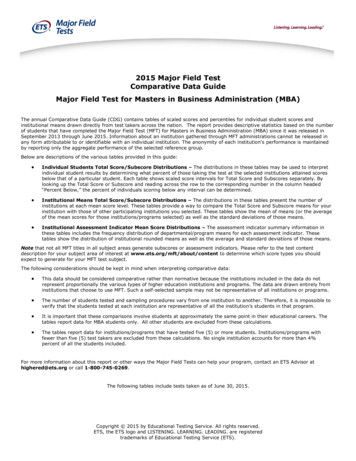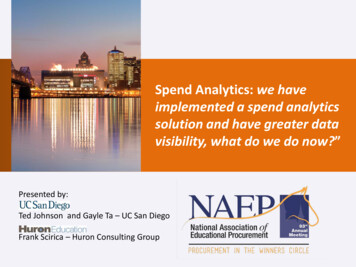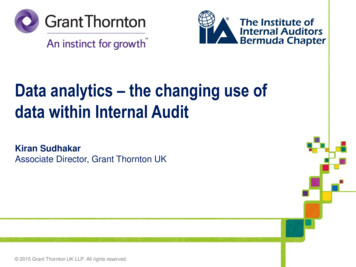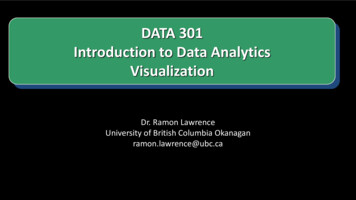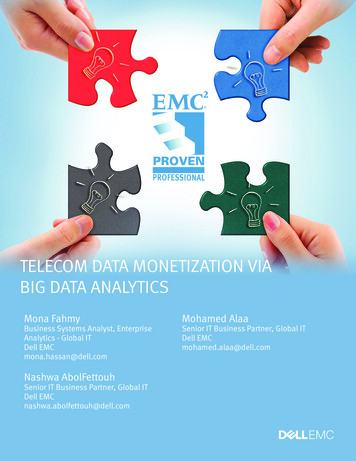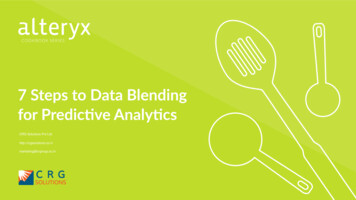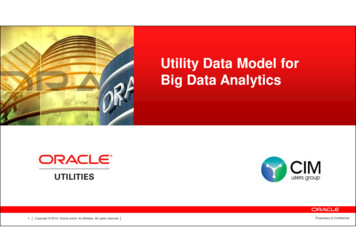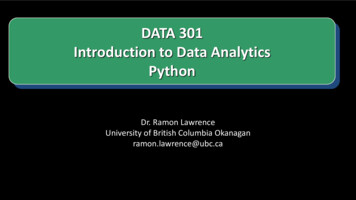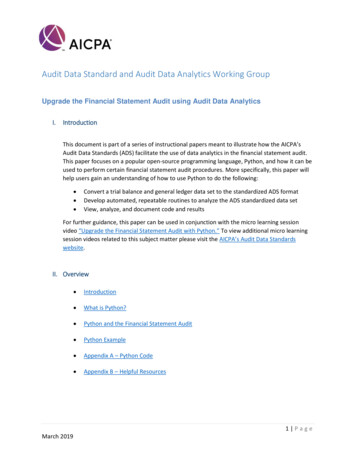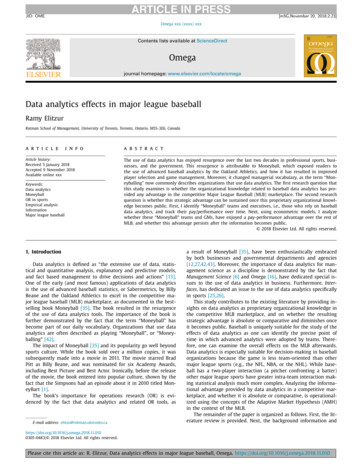
Transcription
ARTICLE IN PRESSJID: OME[m5G;November 20, 2018;2:23]Omega xxx (xxxx) xxxContents lists available at ScienceDirectOmegajournal homepage: www.elsevier.com/locate/omegaData analytics effects in major league baseballRamy ElitzurRotman School of Management, University of Toronto, Toronto, Ontario, M5S-3E6, Canadaa r t i c l ei n f oArticle history:Received 5 January 2018Accepted 9 November 2018Available online xxxKeywords:Data analyticsMoneyballOR in sportsEmpirical analysisInformationMajor league baseballa b s t r a c tThe use of data analytics has enjoyed resurgence over the last two decades in professional sports, businesses, and the government. This resurgence is attributable to Moneyball, which exposed readers tothe use of advanced baseball analytics by the Oakland Athletics, and how it has resulted in improvedplayer selection and game management. Moreover, it changed managerial vocabulary, as the term “Moneyballing” now commonly describes organizations that use data analytics. The first research question thatthis study examines is whether the organizational knowledge related to baseball data analytics has provided any advantage in the competitive Major League Baseball (MLB) marketplace. The second researchquestion is whether this strategic advantage can be sustained once this proprietary organizational knowledge becomes public. First, I identify “Moneyball” teams and executives, i.e., those who rely on baseballdata analytics, and track their pay/performance over time. Next, using econometric models, I analyzewhether these “Moneyball” teams and GMs, have enjoyed a pay-performance advantage over the rest ofMLB, and whether this advantage persists after the information becomes public. 2018 Elsevier Ltd. All rights reserved.1. IntroductionData analytics is defined as “the extensive use of data, statistical and quantitative analysis, explanatory and predictive models,and fact based management to drive decisions and actions” [13].One of the early (and most famous) applications of data analyticsis the use of advanced baseball statistics, or Sabermetrics, by BillyBeane and the Oakland Athletics to excel in the competitive major league baseball (MLB) marketplace, as documented in the bestselling book Moneyball [35]. The book resulted in the resurgenceof the use of data analytics tools. The importance of the book isfurther demonstrated by the fact that the term “Moneyball” hasbecome part of our daily vocabulary. Organizations that use dataanalytics are often described as playing “Moneyball”, or “Moneyballing” [42].The impact of Moneyball [35] and its popularity go well beyondsports culture. While the book sold over a million copies, it wassubsequently made into a movie in 2011. The movie starred BradPitt as Billy Beane, and was nominated for six Academy Awards,including Best Picture and Best Actor. Ironically, before the releaseof the movie, the book entered into popular culture, shown by thefact that the Simpsons had an episode about it in 2010 titled MoneyBart [1].The book’s importance for operations research (OR) is evidenced by the fact that data analytics and related OR tools, asE-mail address: elitzu@rotman.utoronto.caa result of Moneyball [35], have been enthusiastically embracedby both businesses and governmental departments and agencies[12,27,42,43]. Moreover, the importance of data analytics for management science as a discipline is demonstrated by the fact thatManagement Science [6] and Omega [16], have dedicated special issues to the use of data analytics in business. Furthermore, Interfaces, has dedicated an issue to the use of data analytics specificallyin sports [25,26].This study contributes to the existing literature by providing insights on data analytics as proprietary organizational knowledge inthe competitive MLB marketplace, and on whether the resultingstrategic advantage is absolute or comparative and diminishes onceit becomes public. Baseball is uniquely suitable for the study of theeffects of data analytics as one can identify the precise point oftime in which advanced analytics were adopted by teams. Therefore, one can examine the overall effects on the MLB afterwards.Data analytics is especially suitable for decision-making in baseballorganizations because the game is less team-oriented than othermajor league sports (e.g., the NFL, NBA, or the NHL). While baseball has a two-player interaction (a pitcher confronting a batter)other major league sports have greater intra-team interaction making statistical analysis much more complex. Analyzing the informational advantage provided by data analytics in a competitive marketplace, and whether it is absolute or comparative, is operationalized using the concepts of the Adaptive Market Hypothesis (AMH)in the context of the MLB.The remainder of the paper is organized as follows. First, the literature review is provided. Next, the background information -0483/ 2018 Elsevier Ltd. All rights reserved.Please cite this article as: R. Elitzur, Data analytics effects in major league baseball, Omega, https://doi.org/10.1016/j.omega.2018.11.010
JID: OME2ARTICLE IN PRESS[m5G;November 20, 2018;2:23]R. Elitzur / Omega xxx (xxxx) xxxthe research hypotheses are discussed. This is followed by a discussion of the sample and data used in the study. The methodologysection follows the data section and covers the models and empirical tests employed. The results, including robustness tests, arethe penultimate portion of the paper. Lastly, concluding remarksare offered, including the limitations of the study, and avenues forfuture research.2. Literature ReviewLo [38–40] proposes the theory of adaptive market efficiency incapital markets, which maintains that market dynamics are drivenby the interaction among selfish individuals, competition, adaptation, natural selection, and environmental conditions. Lo [39] argues that such adaptation is driven by competition, as the interactions among various market participants are governed by natural selection. Furthermore, this notion reconciles market efficiencywith behavioral economics and documented behavioral biases byinvestors [51]. The AMH argues that while market participants often make mistakes, they learn from them and adapt their behavioraccordingly [38–40]. Consequently, the line of studies on the vanishing over time of mispricing anomalies is essentially an application of the AMH [30,44,47,49].Liberatore and Luo [36] assert that data analytics goes well beyond mere logical analysis that use analytical methodologies. Instead, they argue that data analytics encompasses analytical processes that make data actionable, leading to insights that can beused for organizational decision-making and problem solving. Libratore and Luo [36] go on and suggest that “OR professionalsmust acquire or strengthen their technical and managerial skillsto succeed in the new analytics environment, moving from being “one-and-done” problem solvers to solution providers”. (p.323).Thus, arguing that OR has to adapt and embed data analytics as anintegral part of its tools. Consequently, Moneyball [35], in essence,describes how the use of data analytics in baseball, in particularthe use of Sabermetrics, has led the Oakland Athletics to superiorperformance despite the low payroll of the team. As such, the useof advanced baseball analytics by the Oakland Athletics is arguablyone of the early application of data analytics [52].The few academic papers on baseball deal mostly with specific aspects of the game instead of the overall pay-performanceconcept [7,11,14,15,36]. An early study that examines the payperformance relation in MLB is Scully [48], but it does so at theindividual player level, rather than team level, and, moreover, dueto the period that it examines, it does not look at the effects ofdata analytics. Hakes and Sauer [31] provide an interesting analysis of “Moneyball” effects but the study looks only at offensivemeasures, as opposed to overall team performance (e.g., WAR) and,moreover, does not track individual baseball executives’ effects, oridentify analytics oriented teams.Of particular importance is the study by Troilo et al. [52] whoexamine reality versus perception in the adoption of business analytics tools to enhance gate receipts revenues by North Americanprofessional sports teams. The results demonstrate that the adoption of business analytics by professional sport teams has mademanagers realize that their revenues are growing. The second finding is that, consistent with the managers’ perceptions, revenuegrowth is driven by business analytics.Another important study is Chan and Fearing [11], who developa new and highly-tractable optimization-based approach for evaluating baseball rosters in the presence of uncertainty due to therisk of player injury. Using this approach, the authors calculate thevalue of flexibility in different contexts and compared these valuesacross teams.An important line of literature focuses on the role of organizational knowledge for sustained strategic advantage. Barney[2] examines the role of firm resources, including information andknowledge, in generating sustained competitive advantage. A prerequisite for the value provided by these resources is that they arecontrolled by the firm, so it can formulate and implement strategies to improve its effectiveness and efficiency. As such, these assets have to be rare, valuable and, moreover, inimitable. Barney argues that the three reasons for these resources to be inimitableare: (a) unique historical conditions that enabled the firm to acquire these assets, (b) the link between them and the firm’s sustained competitive advantage is not well understood, or (c) theyare socially complex.Building on Barney [2], Liebeskind [37] argues that knowledgemust be protected for a firm to create and maintain its competitive advantage. One problem with the protection of knowledge isthat, as opposed to tangible assets, its ownership cannot be asserted unambiguously and, thus, cannot be protected at low costs(for example, one cannot build a fence to protect knowledge, asopposed to a building). Another problem is that, in contrast withtangible assets, knowledge is not clearly observable and, hence, itsexpropriation or illegal imitation cannot be easily detected. Liebeskind [37] asserts that the firm must use a cost-benefit analysisto choose between internalizing this knowledge (i.e., doing its bestto keep the ‘secret sauce’ secret) and legal protection (which, forexample, necessitates the disclosure of some crucial detail whenapplying for a patent).Gold et al. [29] synthesize the ideas of Barney [2] and Liebeskind [37] and apply them to information systems (IS) as partof knowledge process capabilities. The analysis of the responsesto the survey that the study employs confirm the importance ofknowledge protection in the context of IS–related sustained competitive advantage.Consequently, I argue that MLB provides a unique opportunityto investigate organizational knowledge and its protection for sustained competitive advantage in the context of major league baseball. Thus, this study contributes to the extant literature by examining “Moneyball” in the context of the following research questions:1. Does organizational knowledge in the form of data analyticsprovide a strategic advantage in the competitive MLB marketplace?2. Is the strategic advantage that data analytics provides to MLBteams absolute, or comparative, thus, diminishes once this organizational knowledge becomes public?3. Background and hypothesis developmentMajor League Baseball (MLB) is the oldest of all North American professional sport leagues. It currently has 30 teams in playing two leagues: 15 teams in the American League (AL) and 15teams in the National League (NL). Each League has three divisions (East, Central and West), with 5 teams in each one. Each ofthe MLB teams plays 162 games in the regular season, which takesplace from early April to early October that year. The regular season games are normally played in three-game-series (sometimes atwo- or four-game series), where each MLB team plays 81 games athome and 81 games on the road (most of these games are playedwithin the league that the team belongs to, but each team also participates in 20 interleague games each season). The win-loss recordin the regular season determines which teams from each leagueplay in the post-season, and how they are seeded. The seeding ofteams is important because it determines the matchups and thehome field advantage, which goes to the higher seeded team. Ofall major league sports, baseball is arguably the hardest for teamsto make it to the post-season as only a third of MLB teams under the current system make it to the post-season. In contrast, inPlease cite this article as: R. Elitzur, Data analytics effects in major league baseball, Omega, https://doi.org/10.1016/j.omega.2018.11.010
JID: OMEARTICLE IN PRESS[m5G;November 20, 2018;2:23]R. Elitzur / Omega xxx (xxxx) xxxthe NFL twelve out of 32 teams make it to the post-season, andin the NBA and the NHL sixteen teams out of 31 make it to thepost-season. As such, the win-loss record is crucial for MLB teamsand thus it is essential for them to optimally draft players, tradefor better players and, of course, optimally manage each game.Moneyball [35] tells the story of Billy Beane, the GM of the Oakland Athletics, and his quest to use data analytics for player selection (both drafting them and trading with other teams for them)and game management. The shift of the team from using heuristics to data analytics was necessary as the Athletics’ ownershipchanged in the mid-nineties and the new owners decided to cutthe payroll. The successful implementation of data analytics by theOakland Athletics to find undervalued players is evidenced by thefact that the team made it to the playoffs each year between 20 0 0and 2003, despite having one of the lowest payrolls in MLB.The study focuses on WAR, which is widely thought to be themost important Sabermetric statistic in baseball [10] and whosecalculation is explained in detail in Appendix 1. WAR was developed, as FanGraphs [20] states, to capture the total contributionsof a player to his team above the league’s baseline.Of all major league sports, baseball is uniquely suitable for thestudy of the pay-performance relation because it is essentially agame of one-on-one matchups between a batter and a pitcher. Theone-on-one aspect of the game is important as it allows a better statistical analysis of players themselves vs. other major leaguesports where team dynamics and interactions among players complicate the matter (e.g., the NFL, NBA, NHL and soccer).Using major league baseball provides a relatively simple way tomeasure the intrinsic value of data analytics with respect to players, and to test whether markets quickly adapt to valuation anomalies, thus, addressing the question of whether the advantage thatdata analytics provides is absolute or diminishes once this information becomes public. One of the differentiating features of thispaper, compared with other studies, is that it focuses on how organizations adapt within a single industry. This focus on the organization themselves (rather than market prices overall) makes itpossible to examine on a deeper level which organizations adaptmore quickly, and what the factors are that determine the adjustment process. Moreover, the focus of this study on key executives in MLB organizations allows me to specifically identify theentrance of the new data analytics baseball executive species who,as Lo [38,40] argues, are better suited to deal with the environment, and thus drive out the existing species (non-data- analyticsbaseball executives), whose decision making process is maladaptive with respect to the new environment in MLB.Data analytics in the MLB fits Barney’s [2] definition of a firm’sresource: it is controlled by MLB teams to formulate and implement strategies to improve their effectiveness and efficiency. Moreover, until the publication of book the link between this knowledge and the teams’ sustained competitive advantage was ambiguous. Consistent with Liebeskind [37], the organizational knowledgerelated to the use of data analytics cannot be patented, or otherwise legally protected, and, thus, “Moneyball” teams had to chooseinternalization of this knowledge to protect it, as opposed to legal protection. Consequently, my first hypothesis states that having a unique data analytics information set provides a competitiveadvantage for “Moneyball” teams in the competitive MLB marketplace.Hypothesis 1. Proprietary organizational knowledge in the form ofdata analytics results in a pay-performance competitive advantage for“Moneyball” teams over other MLB teams.Once Moneyball [35] was published, the link between dataanalytics teams’ knowledge and their sustained competitive advantage became unambiguous, making this resource imitable. Themanner that “Moneyball” knowledge leaks take is through the3movement of front office personnel from one team to another,as forewarned by Liebeskind [37]. As such, the second researchhypothesis stems from the idea that the competitive advantagethat data analytics provides is comparative and not absolute, and,consistent with AMH, once this information becomes available toother market participants, the ensuing advantage vanishes overtime.Hypothesis 2. Data analytics related organizational knowledge provides a comparative, and not absolute, strategic advantage to “Moneyball” teams and, hence, the pay-performance advantages to “Moneyball” teams over other teams vanish over time once this knowledgebecomes publicly available.The advantage derived from baseball data analytics, however,could be related to the executive in charge of the front office (theGM) and his philosophy, rather than the team. Moreover, one canargue that, consistent with Lo [38–40] this migration of decisionmakers is the main driver of the leakage of organizational knowledge. Consequently, the following hypotheses, similar to Hypotheses 1 and 2 above, are in the context of front office executives, asopposed to teams:Hypothesis 3. Proprietary organizational knowledge in the form ofdata analytics provides a pay-performance advantage for “Moneyball”executives over other executives.Hypothesis 4. Data analytics related organizational knowledge provides a comparative, and not absolute, strategic advantage to MLB executives and, hence, the pay-performance advantages to “Moneyball”executives over other executives vanish once this knowledge becomespublicly available.4. entagewinsjandNormPayj ,andasTeam j PayrollAverage Payroll in MLB baseball t hat year wit hout team j(all variable definitions are provided in Appendix 2). In essence, this pay measureis the team payroll relative to the league average in that yearwithout that team (normalized payroll). The use of normalizedpayroll helps avoid any potential MLB salary inflation effects,which have occurred during the period studied while overallaverage win percentages remains roughly the same.4.1. Tests for Hypotheses 1 and 2The three sub-periods that are used in the study to test Hypotheses 1 and 2 above are as follows:1. 1997–2002: The period preceding the publication of Moneyball[35] starting in 1997, the year that Oakland A’s began to useadvanced data analytics.2. 20 03–20 08: The period immediately following the publicationof Moneyball [35].3. 2009–2013: The most recent period, culminating with the lastyear in the sample.Define SABR1 , SABR2 and SABR3 as fixed effect dummy variables denoting a “Moneyball” (data analytics) team in period 1,2, and 3, respectively. To obtain a more institutive interpretation of the NormPay effects on Win%, define SNP as scaled NormPay by quintiles (scaled between zero and one). Also, three interaction dummies are created to test the variable effects of“Moneyball” teams in pe
time in which advanced analytics were adopted by teams. There- fore, one can examine the overall effects on the MLB afterwards. Data analytics is especially suitable for decision-making in baseball organizations because the game is less team-oriented than other major league sports (e.g., the NFL, NBA, or the NHL). While base-
